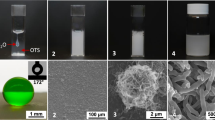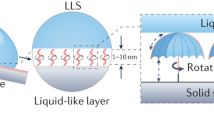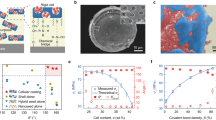Abstract
High-performance coatings that durably and fully repel liquids are of interest for fundamental research and practical applications. Such coatings should allow for droplet beading, roll off and bouncing, which is difficult to achieve for ultralow surface tension liquids. Here we report a bottom-up approach to prepare super-repellent coatings using a mixture of fluorosilanes and cyanoacrylate. On application to surfaces, the coatings assemble into thin films of locally multi-re-entrant hierarchical structures with very low surface energies. The resulting materials are super-repellent to solvents, acids and bases, polymer solutions and ultralow surface tension liquids, characterized by ultrahigh liquid contact angles (>150°) and negligible roll-off angles (~0°). Furthermore, the coatings are transparent, durable and demonstrate universal liquid bouncing, tailored responsiveness and anti-freezing properties, and are thus a promising alternative to existing synthetic super-repellent coatings.
This is a preview of subscription content, access via your institution
Access options
Access Nature and 54 other Nature Portfolio journals
Get Nature+, our best-value online-access subscription
$29.99 / 30 days
cancel any time
Subscribe to this journal
Receive 12 print issues and online access
$259.00 per year
only $21.58 per issue
Buy this article
- Purchase on Springer Link
- Instant access to full article PDF
Prices may be subject to local taxes which are calculated during checkout




Similar content being viewed by others
Data availability
Data supporting the findings of this study are available within the article (and its Supplementary Information) and from the corresponding authors upon reasonable request.
References
Li, Y., Quere, D., Lv, C. & Zheng, Q. Monostable superrepellent materials. Proc. Natl Acad. Sci. USA 114, 3387–3392 (2017).
Schutzius, T. M. et al. Spontaneous droplet trampolining on rigid superhydrophobic surfaces. Nature 527, 82–85 (2015).
Vakarelski, I. U., Patankar, N. A., Marston, J. O., Chan, D. Y. & Thoroddsen, S. T. Stabilization of Leidenfrost vapour layer by textured superhydrophobic surfaces. Nature 489, 274–277 (2012).
Yong, J., Chen, F., Yang, Q., Huo, J. & Hou, X. Superoleophobic surfaces. Chem. Soc. Rev. 46, 4168–4217 (2017).
Blossey, R. Self-cleaning surfaces—virtual realities. Nat. Mater. 2, 301–306 (2003).
Lu, Y. et al. Robust self-cleaning surfaces that function when exposed to either air or oil. Science 347, 1132–1135 (2015).
Erbil, H. Y., Demirel, A. L., Avci, Y. & Mert, O. Transformation of a simple plastic into a superhydrophobic surface. Science 299, 1377–1380 (2003).
Pan, S., Kota, A. K., Mabry, J. M. & Tuteja, A. Superomniphobic surfaces for effective chemical shielding. J. Am. Chem. Soc. 135, 578–581 (2013).
Lee, H., Lee, B. P. & Messersmith, P. B. A reversible wet/dry adhesive inspired by mussels and geckos. Nature 448, 338–341 (2007).
N’Guessan, H. E. et al. Water tribology on graphene. Nat. Commun. 3, 1242 (2012).
Epstein, A. K., Wong, T.-S., Belisle, R. A., Boggs, E. M. & Aizenberg, J. Liquid-infused structured surfaces with exceptional anti-biofouling performance. Proc. Natl Acad. Sci. USA 109, 13182–13187 (2012).
Kota, A. K., Kwon, G., Choi, W., Mabry, J. M. & Tuteja, A. Hygro-responsive membranes for effective oil–water separation. Nat. Commun. 3, 1025 (2012).
Han, Y., Xu, Z. & Gao, C. Ultrathin graphene nanofiltration membrane for water purification. Adv. Funct. Mater. 23, 3693–3700 (2013).
Zheng, Y. et al. Directional water collection on wetted spider silk. Nature 463, 640–643 (2010).
Timonen, J. V. I., Latikka, M., Leibler, L., Ras, R. H. A. & Ikkala, O. Switchable static and dynamic self-assembly of magnetic droplets on superhydrophobic surfaces. Science 341, 253–257 (2013).
Bird, J. C., Dhiman, R., Kwon, H.-M. & Varanasi, K. K. Reducing the contact time of a bouncing drop. Nature 503, 385–388 (2013).
Kreder, M. J., Alvarenga, J., Kim, P. & Aizenberg, J. Design of anti-icing surfaces: smooth, textured or slippery? Nat. Rev. Mater. 1, 15003 (2016).
Tuteja, A. et al. Designing superoleophobic surfaces. Science 318, 1618–1622 (2007).
Liu, T. & Kim, C. J. Turning a surface superrepellent even to completely wetting liquids. Science 346, 1096–1100 (2014).
Deng, X., Mammen, L., Butt, H.-J. & Vollmer, D. Candle soot as a template for a transparent robust superamphiphobic coating. Science 335, 67–70 (2011).
Wong, T.-S. et al. Bioinspired self-repairing slippery surfaces with pressure-stable omniphobicity. Nature 477, 443–447 (2011).
Azimi, G., Dhiman, R., Kwon, H.-M., Paxson, A. T. & Varanasi, K. K. Hydrophobicity of rare-earth oxide ceramics. Nat. Mater. 12, 315–320 (2013).
Richardson, J. J., Björnmalm, M. & Caruso, F. Technology-driven layer-by-layer assembly of nanofilms. Science 348, aaa2491 (2015).
Steele, A., Bayer, I. & Loth, E. Inherently superoleophobic nanocomposite coatings by spray atomization. Nano Lett. 9, 501–505 (2009).
Zhang, J. & Seeger, S. Superoleophobic coatings with ultralow sliding angles based on silicone nanofilaments. Angew. Chem. Int. Ed. 50, 6652–6656 (2011).
Stuart, M. A. C. et al. Emerging applications of stimuli-responsive polymer materials. Nat. Mater. 9, 101–113 (2010).
Tian, X., Verho, T. & Ras, R. H. A. Moving superhydrophobic surfaces toward real-world applications. Science 352, 142–143 (2016).
Pan, S., Guo, R. & Xu, W. Durable superoleophobic fabric surfaces with counterintuitive superwettability for polar solvents. AIChE J. 60, 2752–2756 (2014).
Yao, X. et al. Adaptive fluid-infused porous films with tunable transparency and wettability. Nat. Mater. 12, 529–534 (2013).
Wong, W. S. Y. et al. Omnidirectional self-assembly of transparent superoleophobic nanotextures. ACS Nano 11, 587–596 (2017).
Xu, Z., Zhao, Y., Wang, H., Wang, X. & Lin, T. A superamphiphobic coating with an ammonia-triggered transition to superhydrophilic and superoleophobic for oil–water separation. Angew. Chem. Int. Ed. 54, 4527–4530 (2015).
Wenzel, R. N. Resistance of solid surfaces to wetting by water. Ind. Eng. Chem. 28, 988–994 (1936).
Cassie, A. B. D. & Baxter, S. Wettability of porous surfaces. Trans. Faraday Soc. 40, 546–551 (1944).
Bormashenko, E., Pogreb, R., Balter, S. & Aurbach, D. Electrically controlled membranes exploiting Cassie–Wenzel wetting transitions. Sci. Rep. 3, 3028 (2013).
Hao, C. et al. Superhydrophobic-like tunable droplet bouncing on slippery liquid interfaces. Nat. Commun. 6, 7986 (2015).
Jung, S., Tiwari, M. K., Doan, N. V. & Poulikakos, D. Mechanism of supercooled droplet freezing on surfaces. Nat. Commun. 3, 615 (2012).
Golovin, K. et al. Designing durable icephobic surfaces. Sci. Adv. 2, e1501496 (2016).
Campos, R. et al. Superoleophobic surfaces through control of sprayed-on stochastic topography. Langmuir 28, 9834–9841 (2012).
Golovin, K., Lee, D. H., Mabry, J. M. & Tuteja, A. Transparent, flexible, superomniphobic surfaces with ultra-low contact angle hysteresis. Angew. Chem. Int. Ed. 52, 13007–13011 (2013).
Srinivasan, S., Chhatre, S. S., Mabry, J. M., Cohen, R. E. & McKinley, G. H. Solution spraying of poly(methyl methacrylate) blends to fabricate microtextured, superoleophobic surfaces. Polymer 52, 3209–3218 (2011).
Grigoryev, A., Tokarev, I., Kornev, K. G., Luzinov, I. & Minko, S. Superomniphobic magnetic microtextures with remote wetting control. J. Am. Chem. Soc. 134, 12916–12919 (2012).
Kota, A. K., Li, Y., Mabry, J. M. & Tuteja, A. Hierarchically structured superoleophobic surfaces with ultralow contact angle hysteresis. Adv. Mater. 24, 5838–5843 (2012).
Verho, T. et al. Reversible switching between superhydrophobic states on a hierarchically structured surface. Proc. Natl Acad. Sci. USA 109, 10210–10213 (2012).
Herminghaus, S. Roughness-induced non-wetting. Europhys. Lett. 52, 165–170 (2000).
Kleingartner, J. A. et al. Designing robust hierarchically textured oleophobic fabrics. Langmuir 31, 13201–13213 (2015).
Mazumder, P. et al. Superomniphobic, transparent, and antireflection surfaces based on hierarchical nanostructures. Nano Lett. 14, 4677–4681 (2014).
Jung, Y. C. & Bhushan, B. Mechanically durable carbon nanotube−composite hierarchical structures with superhydrophobicity, self-cleaning, and low-drag. ACS Nano 3, 4155–4163 (2009).
Tuteja, A., Choi, W., McKinley, G. H., Cohen, R. E. & Rubner, M. F. Design parameters for superhydrophobicity and superoleophobicity. MRS Bull. 33, 752–758 (2008).
de Ruiter, J., Lagraauw, R., van den Ende, D. & Mugele, F. Wettability-independent bouncing on flat surfaces mediated by thin air films. Nat. Phys. 11, 48–53 (2014).
Qian, J. & Law, C. K. Regimes of coalescence and separation in droplet collision. J. Fluid Mech. 331, 59–80 (1997).
Acknowledgements
This research was conducted jointly and funded by the National Natural Science Foundation of China (NSFC grant nos 51703056, 21707031, 21606081, 21527810, 21521063, 21575036, 21307029, 21221003, 21205034 and 21190041), National Key Basic Research Program (project no. 2011CB911000), China Postdoctoral Science Foundation (project no. 2016M602402), China Scholarship Council (file no. 201606130022), Natural Science Foundation of Hunan Province of China (project no. 2018JJ3028), Horizon 2020/European Union (grant agreement no. 745676), Australian Research Council (ARC) Centre of Excellence in Convergent Bio-Nano Science and Technology (project no. CE140100036) and the ARC under the Australian Laureate Fellowship scheme (grant no. FL120100030).
Author information
Authors and Affiliations
Contributions
R.G. and S.P. conceived the ideas and, with the help of W.X., J.J. and F.C., designed and conducted the experiments, and analysed the data. All the authors discussed and interpreted the results and contributed to the writing of the paper.
Corresponding authors
Ethics declarations
Competing interests
The authors declare no competing interests.
Additional information
Publisher’s note: Springer Nature remains neutral with regard to jurisdictional claims in published maps and institutional affiliations.
Supplementary Information
Supplementary Information
Supplementary Video Legends 1–26, Supplementary Figures 1–36, Supplementary Tables 1–3, Supplementary References 1–31
Supplementary Video 1
Hexane drop bouncing on a planar superomniphobic (SOP) substrate
Supplementary Video 2
Pentane drop rolls off a SOP slope of 18°
Supplementary Video 3
Pentane drop rolls off a SOP slope of 37°
Supplementary Video 4
Pentane drop bounces on a SOP woven fabric (low Weber number)
Supplementary Video 5
Pentane drop breaks through the facial SOP coating (medium Weber number)
Supplementary Video 6
Pentane drop bounces on a full SOP coating (medium Weber number)
Supplementary Video 7
Jumping satellite drop of pentane (high Weber number)
Supplementary Video 8
Coalescence of extruded satellite drops of pentane (higher Weber number)
Supplementary Video 9
Continuous impacting of pentane jet
Supplementary Video 10
Bouncing of HF on coated TLC plate
Supplementary Video 11
Bouncing of PVDF solution
Supplementary Video 12
Bouncing of FC-72 at high temperatures
Supplementary Video 13
Bouncing of FC-72 at high atmospheres
Supplementary Video 14
Impact of liquid nitrogen droplet on a coated TLC plate
Supplementary Video 15
Rolling off liquid nitrogen filament on a coated TLC plate
Supplementary Video 16
Impact of liquid nitrogen droplet on a coated print paper
Supplementary Video 17
Wetting of liquid nitrogen on an uncoated TLC plate
Supplementary Video 18
Freezing of water on a five-tier substrate
Supplementary Video 19
Freezing of water on a four-tier substrate
Supplementary Video 20
Freezing of water on a three-tier (microstructure) substrate
Supplementary Video 21
Freezing of water on a three-tier (nanostructure) substrate
Supplementary Video 22
Freezing of water on a two-tier substrate
Supplementary Video 23
Freezing of water on a one-tier (control) substrate
Supplementary Video 24
Impinging water drop on a −20 °C SOP substrate (We = 3)
Supplementary Video 25
Reduced contact time of water droplet with a −20 °C SOP substrate (We = 60)
Supplementary Video 26
Scratch durability testing
Rights and permissions
About this article
Cite this article
Pan, S., Guo, R., Björnmalm, M. et al. Coatings super-repellent to ultralow surface tension liquids. Nature Mater 17, 1040–1047 (2018). https://doi.org/10.1038/s41563-018-0178-2
Received:
Accepted:
Published:
Issue Date:
DOI: https://doi.org/10.1038/s41563-018-0178-2
This article is cited by
-
Durable superhydrophobic coatings for prevention of rain attenuation of 5G/weather radomes
Nature Communications (2023)
-
Ultra-durable superhydrophobic cellular coatings
Nature Communications (2023)
-
Superhydrophobic Purple Orchid Leaves: Variation in Surface Morphology During the Vegetation Stages Leading to Diversity in Wettability
Journal of Bionic Engineering (2023)
-
Spontaneous, scalable, and self-similar superhydrophobic coatings for all-weather deicing
Nano Research (2023)
-
Study on the Corrosion Resistance of Hydrophobic Cement Mortar
Iranian Journal of Science and Technology, Transactions of Civil Engineering (2023)



